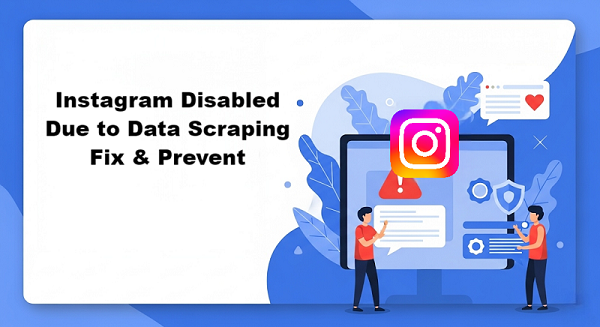Generic Unblocker: What It Is, How It Works & Safe Uses
Explore what a generic unblocker is, its mechanisms, safe applications for scraping, streaming, and more—plus step-by-step setups and 2025 trends.
Dec 5, 2025
Description: Learn why Instagram blocks scraping, follow our recovery steps, and implement proxy-powered prevention for safe, compliant data gathering.
Instagram’s vast user base makes it one of the prime targets for data scraping, extracting information like profiles, hashtags, or stories for insights or analysis. However, this can trigger Instagram’s anti-scraping defenses, leading to temporary blocks or full account disablement. Whether you’re a beginner marketer testing simple scripts or a pro running enterprise-scale crawls, this guide shows you why blocks happen, how to recover step by step, and what practical measures—using the official API, best-practice automation, and residential proxies—you need to avoid future issues.

Instagram combines several detection methods to protect user privacy and platform integrity. Understanding these will help you adjust your approach:
API Limits: e.g., 200 calls/hour per access token.
Action Limits: e.g,. 50 likes, 20 follows, 15 comments/h.
Trigger: Exceeding thresholds—even unintentionally—results in “Action Blocked” or disablement.
Pattern Detection: Repetitive, machine-like sequences (e.g., 100 likes in 60 seconds).
Missing Human Signals: No mouse movements, no natural scroll pauses.
IP Flags: Many requests from a single IP—especially data-center ranges—look bot-driven.
Header/Fingerprint Anomalies: Headless-browser fingerprints, mismatched device headers.
Unapproved Scripts/Bots: Custom Python scripts or browser automation not using official endpoints.
High-Throughput Scrapers: Tools that fetch large volumes without human pacing.
| User Type | Typical Activity | Key Risk Factors |
| Casual Marketers | Simple scripts for hashtags or followers. | Hitting rate limits by accident. |
| Researchers & Agencies | Headless browsers, Instaloader-style tools. | Consistent patterns from same IP. |
| Developers & Bot Ops | Large-scale crawls via unofficial APIs. | High request rates from datacenter IPs. |
Beginner Tip: If you’re scraping a handful of posts, start with ≤ 10 requests in one session and note the responses.
Pro Tip: Log every request’s HTTP status; flag any 429/401/403 immediately.
Stop All Automation! Cease any scripts, bots, or proxy rotations before proceeding.
If your account is disabled, don’t panic—recovery is often possible. Follow these detailed steps:
Log in via the mobile app or desktop(e.g., “Tap Settings → Help → Support Inbox” or “Desktop: look for the red banner on your profile”). And screenshot the exact message (e.g., “Your account has been disabled”).
Details to Note: Timestamp, device/browser, IP location.
a. Visit help.instagram.com → Account Access → My Account Was Disabled.
b. Fill in the information required: your full name, username, and email.
c. Attach your clear screenshot.
d. In the description, write: “I believe my account was disabled by mistake. I’ve stopped any automated activity and request a review.”
Editor’s Tip: Never mention specific scripts or scraping tools—frame it as accidental or research use.
If prompted, upload a clear government-issued ID photo or a recent selfie that matches your profile name. Please ensure the photo is an original version.
Check: Instagram’s Support Inbox (app) and your email (including spam).
Timing: Responses can take 24 hours–1 week.
If No Reply: After 3–5 business days, resubmit the form adding “Follow‑up” to the subject..
If appeals fail, create a new account. Immediately implement the prevention steps below to avoid another disablement.
Prevention is better than recovery. Here’s how to scrape responsibly or avoid trouble altogether:
The Graph API enforces limits server-side and reduces the risk of manual threshold breaches.
a. Register as a Facebook Developer.
b. Create an App and generate an access token.
c. Query endpoints (e.g. /me/media, /media/{media-id}) within documented rate limits.
Random Delays: Insert 5–15 second pauses with ± 20% jitter between requests.
Mouse & Scroll Simulation: In browser automation, script at least one mouse move or scroll per action.
Micro-Example (pseudocode):
js
await page.mouse.move(100, 200);
await page.waitForTimeout(random(4000, 8000));
await page.click('button.like');
a. Rotate residential IPs every 30–60 minutes or per 100–200 requests.
b. Geo-Target to align with your audience’s location.
c. Limit to ≤ 3 concurrent connections per Instagram account.
d. Monitor proxy health—if > 5% of requests fail or return 4xx codes, switch to a fresh pool.
Periodically revoke unused apps' permissions in Instagram Settings → Security → Apps and Websites. Only authorize tools that respect Instagram’s Policy.
Automated Alerts: Build a simple script to log and alert on HTTP status codes ≥ 400.
Exponential Back-Off: On a 429 (rate limit), wait 10 minutes, then 20 minutes, then 40, etc.
Device-Fingerprint Management: Use frameworks allowing you to set realistic user-agent, screen resolution, and navigator properties.
Weekly Audits: Review Login Activity in Settings to spot unknown sessions.
By understanding detection methods and combining the official API, thoughtful throttling, and GoProxy’s residential proxies, you can minimize the risk of disablement—whether you’re new to social-media analytics or running enterprise workflows. And if you do get blocked, this structured appeal process will help you get back online quickly.
< Previous
Next >
 Cancel anytime
Cancel anytime No credit card required
No credit card required